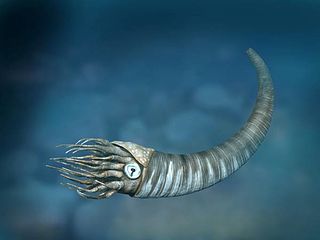
A cephalopod is any member of the molluscan class Cephalopoda such as a squid, octopus, cuttlefish, or nautilus. These exclusively marine animals are characterized by bilateral body symmetry, a prominent head, and a set of arms or tentacles modified from the primitive molluscan foot. Fishers sometimes call cephalopods "inkfish", referring to their common ability to squirt ink. The study of cephalopods is a branch of malacology known as teuthology.
Discosorida are an order of cephalopods that lived from the beginning of the Middle Ordovician, through the Silurian, and into the Devonian. Discosorids are unique in the structure and formation of the siphuncle, the tube that runs through and connects the camerae (chambers) in cephalopods, which unlike those in other orders is zoned longitudinally along the segments rather than laterally. Siphuncle structure indicated that the Discosorida evolved directly from the Plectronoceratida rather than through the more developed Ellesmerocerida, as did the other orders. Finally and most diagnostic, discosorids developed a reinforcing, grommet-like structure in the septal opening of the siphuncle known as the bullette, formed by a thickening of the connecting ring as it draped around the folded back septal neck.

Plectronocerida is a primitive order from which subsequent cephalopod orders are ultimately derived.
The Ellesmerocerida is an order of primitive cephalopods belonging to the subclass Nautiloidea with a widespread distribution that lived during the Late Cambrian and Ordovician.
Clarkoceras is a genus of breviconic ellesmerocerid cephalopods, one of only two genera known to have crossed from the Late Cambrian, Trempealeauan, into the Early Ordovician, Gasconadian. ; the other being Ectenolites.
Bactroceras is a genus of orthoceratoid cephalopods that lived during the early Middle Ordovician, from about 472—464 mya, existing for approximately 8 million years.
Cyrtobaltoceras is an extinct cephalopod genus known from the upper Lower Ordovician Fort Cassin Formation at Valcour, N.Y. that is included in the Nautiloid family Baltoceratidae
The cephalopods have a long geological history, with the first nautiloids found in late Cambrian strata, and purported stem-group representatives present in the earliest Cambrian lagerstätten.

Paradakeoceras is a genus of early Ordovician cephalopods belonging to the nautiloid order Ellesmerocerida.
Conostichoceras is a genus of exogastric, breviconic oncocerids included in the family Nothoceratidae, known from the Middle Devonian of central Europe and Upper Devonian of Australia. It probably lived on and swum above the sea floor.
Dakeoceras is a genus of simple cyrtoconic ellesmeroceratid cephalopods in the fossil record. All known species come from the Lower Canadian epoch (Gasconadian) of North America.
Burenoceras is a genus of small, even tiny, Gasconadian cyrtoconic ellesmeroceratids in which the phragmocone—the chambered portion—is shorter that the living chamber.
Plectronoceratoidea is a superorder or subclass containing primitive nautiloids from the Late Cambrian and Early Ordovician. This group is best considered a paraphyletic grade of early cephalopods, as it contains the ancestors of subsequent post-Cambrian cephalopod orders.
Cartersoceras is a genus of nautiloid cephalopods placed in the Orthocerid family Baltoceratidae, established by Rousseau Flower (1964), for species formally included in part in Murrayoceras, and in part in "Sacotoceras". This group is typical of Murrayoceras in all features except that the siphuncle segments are convex in outline. It is known from the Middle Ordovician of the eastern United States.

Ellesmeroceras is the type genus for the Ellesmeroceratidae, a family of primitive nautiloid cephalopods, that is characterized by its small, generally compressed, gradually expanded, orthoconic shell, found in Lower Ordovician marine sediments. The septa are close spaced and the siphuncle is ventral, about 0.2 the diameter of the shell. Septal necks are typically orthochoanitic but may slant inwardly (loxochoanitic) or reach halfway to the previous septum (hemichoanitic). Connecting rings are thick. As common for the Ellesmerocerida, Ellesmeroceras has diaphragms within the siphuncle tube.
Apocrinoceratidae constitutes a family of Middle Ordovician nautiloid cephalopods characterized by straight or slightly curved, transversely ribbed shells having siphuncles composed of expanded segments, short recurved septal necks, and thick connecting rings. Derivation is from the Protocycloceratidae, a family of ellesmerocerids, which differ in having straight or concave siphuncle segments, but are otherwise similar in form.
Acaroceratidae is family of Upper Cambrian (Trempealeauan) nautiloid cephalopods included in the Ellesmerocerida that contains two known genera, Acaroceras and Weishanuceras, both found in northern China.
Cyclostomiceratidae is an extinct family of Early Ordovician, (Cassinian), ellesmerocerid cephalopods characterized by short, essentially straight shells, a fairly rapidly expanding phragmocone and a ventral siphuncle in which septal necks are almost non-existent and connecting rings are thick and layered. As typical of the Ellesmerocerida, chambers are short, septa close spaced.
Yanhecerida is a small order of Late Cambrian nautiloid cephalopods. They were similar to the more diverse Plectronocerida and Ellesmerocerida, with short shells, closely spaced septa, and diaphragms (partitions) within the siphuncle. Their most distinctive trait is the conical shape of the diaphragms, similar to the endocones which characterize the later nautiloid order Endocerida. While some authors have argued that Yanhecerida should be lumped into Ellesmerocerida, a phylogenetic analysis has maintained that Yanhecerida is a valid clade of early cephalopods closely related to a paraphyletic Ellesmerocerida.

Multiceratoidea is a major subclass or superorder of Paleozoic nautiloid cephalopods. Members of this group can be characterized by nautilosiphonate connecting rings, with an organic inner layer and outer layer of calcitic spherules and blades, similar to the modern nautilus. The earliest-diverging multiceratoids have oncomyarian muscle scars, though several orders trend towards a ventromyarian condition. Multiceratoid shells are generally short and curled, with a relatively small aperture (opening). Cameral deposits are never found among the multiceratoids, though several orders are known to bear endosiphuncular deposits within their siphuncles.




